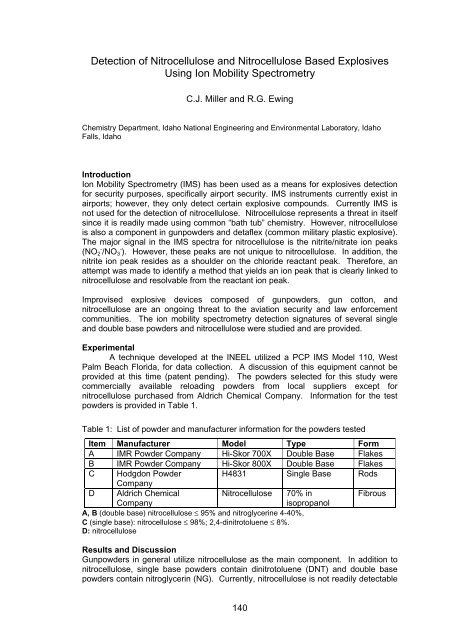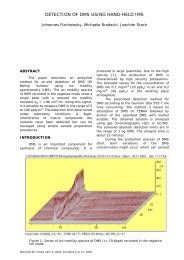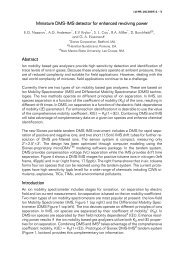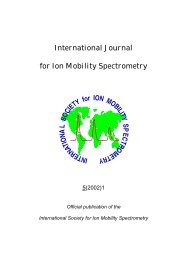Detection of Nitrocellulose and Nitrocellulose Based Explosives ...
Detection of Nitrocellulose and Nitrocellulose Based Explosives ...
Detection of Nitrocellulose and Nitrocellulose Based Explosives ...
You also want an ePaper? Increase the reach of your titles
YUMPU automatically turns print PDFs into web optimized ePapers that Google loves.
<strong>Detection</strong> <strong>of</strong> <strong>Nitrocellulose</strong> <strong>and</strong> <strong>Nitrocellulose</strong> <strong>Based</strong> <strong>Explosives</strong>Using Ion Mobility SpectrometryC.J. Miller <strong>and</strong> R.G. EwingChemistry Department, Idaho National Engineering <strong>and</strong> Environmental Laboratory, IdahoFalls, IdahoIntroductionIon Mobility Spectrometry (IMS) has been used as a means for explosives detectionfor security purposes, specifically airport security. IMS instruments currently exist inairports; however, they only detect certain explosive compounds. Currently IMS isnot used for the detection <strong>of</strong> nitrocellulose. <strong>Nitrocellulose</strong> represents a threat in itselfsince it is readily made using common “bath tub” chemistry. However, nitrocelluloseis also a component in gunpowders <strong>and</strong> detaflex (common military plastic explosive).The major signal in the IMS spectra for nitrocellulose is the nitrite/nitrate ion peaks(NO 2 - /NO 3 - ). However, these peaks are not unique to nitrocellulose. In addition, thenitrite ion peak resides as a shoulder on the chloride reactant peak. Therefore, anattempt was made to identify a method that yields an ion peak that is clearly linked tonitrocellulose <strong>and</strong> resolvable from the reactant ion peak.Improvised explosive devices composed <strong>of</strong> gunpowders, gun cotton, <strong>and</strong>nitrocellulose are an ongoing threat to the aviation security <strong>and</strong> law enforcementcommunities. The ion mobility spectrometry detection signatures <strong>of</strong> several single<strong>and</strong> double base powders <strong>and</strong> nitrocellulose were studied <strong>and</strong> are provided.ExperimentalA technique developed at the INEEL utilized a PCP IMS Model 110, WestPalm Beach Florida, for data collection. A discussion <strong>of</strong> this equipment cannot beprovided at this time (patent pending). The powders selected for this study werecommercially available reloading powders from local suppliers except fornitrocellulose purchased from Aldrich Chemical Company. Information for the testpowders is provided in Table 1.Table 1: List <strong>of</strong> powder <strong>and</strong> manufacturer information for the powders testedItem Manufacturer Model Type FormA IMR Powder Company Hi-Skor 700X Double Base FlakesB IMR Powder Company Hi-Skor 800X Double Base FlakesC Hodgdon Powder H4831 Single Base RodsCompanyD Aldrich Chemical<strong>Nitrocellulose</strong> 70% inFibrousCompanyisopropanolA, B (double base) nitrocellulose ≤ 95% <strong>and</strong> nitroglycerine 4-40%,C (single base): nitrocellulose ≤ 98%; 2,4-dinitrotoluene ≤ 8%.D: nitrocelluloseResults <strong>and</strong> DiscussionGunpowders in general utilize nitrocellulose as the main component. In addition tonitrocellulose, single base powders contain dinitrotoluene (DNT) <strong>and</strong> double basepowders contain nitroglycerin (NG). Currently, nitrocellulose is not readily detectable140
with ion mobility spectrometry (IMS) systems. Due to the polymeric nature <strong>of</strong> thenitrocellulose, it is anticipated to produce only a nitrate signal due to thermalbreakdown <strong>of</strong> the structure, if any response is achieved. A technique developed atINEEL (patent pending) provides ion mobility spectra with distinct nitrocellulosepeaks. A nitrocellulose st<strong>and</strong>ard (diluted in isopropanol) containing 100 ng waspresented to the IMS using the INEEL technique. The resulting spectrum along witha background is shown in Figure 1. This technique was used for detecting thedouble base powders Hi-Skor 800X <strong>and</strong> Hi-Skor 700X (Figures 2 & 3) <strong>and</strong> the singlebase powder H4831 (Figure 4). The peak appearing at a drift time <strong>of</strong> about 6.3ms,indicated with an asterisk, is the unique peak <strong>of</strong> interest to nitrocellulose. The otherpeaks present include the Cl - reactant ion at about 2.8ms followed by a nitrite <strong>and</strong>nitrate peaks at 3.5 <strong>and</strong> 4.5ms respectively. The other peaks in the spectra couldcome from fragmentation or NG <strong>and</strong> DNT present in the powders. These otherpeaks were not confirmed. Although this method is still being developed, it appearsto provide a peak for nitrocellulose that is distinctively different than the nitrite <strong>and</strong>nitrate ions.reactant ion peaknitrate ionRelative Intensitynitriteion*100ng nitrocellulose in methanolnitrate ionmethanol blank0 5 10 15 20Drift Time (ms)Figure 1:IMS spectra <strong>of</strong> nitrocellulose dissolved in isopropanol using a technique developed atthe INEEL.141
Relative Intensity*Hi-Skor 800xBackground0 5 10 15 20Drift Time (ms)Figure 2.IMS spectra <strong>of</strong> Hi-Skor 800x using a technique developed at the INEEL*Relative IntensityHi-Skor 700xBackground0 5 10 15 20Drift time msFigure 3:IMS spectra <strong>of</strong> Hi-Skor 700x using a technique developed at the INEEL142
*Relative IntensityH4831Background0 5 10 15 20Drift Time (ms)Figure 4:IMS spectra <strong>of</strong> H4831 powder using a technique developed at the INEELAcknowledgementsWork supported by the US Department <strong>of</strong> Energy under DOE Idaho OperationsOffice Contract DE-AC07-99ID13727.143
















